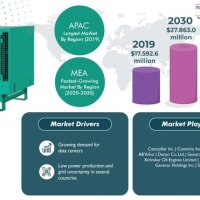Ambient (outdoor) air pollution kills around 4.2 million people every year, reports the World Health Organization (WHO), and road transport has to take considerable blame. Daily, thousands of tons of nitrogen oxides, sulfur dioxide, carbon monoxide, and other harmful gases are emitted from vehicles. Concerned at this, governments of various countries have implemented strict guidelines, such as the Euro VI standards implemented in European Union countries and the Bharat Stage VI emission norms implemented in India, to keep a check on the emission of these gases from automobiles.
One of the best ways to reduce vehicular emission is cutting the weight of the automobiles, which is where adhesives and sealants come in. Thus, with the increasing consciousness on air pollution, the automotive adhesives and sealants market is expected to grow in value from $8,413.7 million in 2017 to $11,871.6 million by 2023, at a CAGR of 6.0% during 2018–2023 (forecast period). These materials are widely used in bonding purposes in the automotive sector, and with the rising focus on lightweight vehicles, their consumption is growing.
Get a sample copy of the market analysis report: https://www.psmarketresearch.com/market-analysis/global-automotive-adhesive-and-sealant-market/report-sample
By decreasing the weight of the automobile, the requirement for propulsion power is reduced. This way, the load on the engine is decreased, which brings down the consumption of fuel and, in turn, the release of toxic substances into the environment. Additionally, with a reduction in fuel consumption, the vehicle has to refill its tanks after longer periods, which further checks the overexploitation of crude oil sources. To reduce the vehicle weight, a lot of the iron and steel components are being replaced by lighter materials, such as aluminum and even carbon fiber.
Due to this, automakers face slight challenges, as keeping these components together via nuts and bolts is not a feasible solution, which is why adhesives and sealants are now being used for the purpose. Apart from their utility in bonding purposes, these materials are also known to make automobiles safer, offer better driving comfort, and improve their performance. With the engine having to propel a lighter load, the machine can push the vehicle at higher speeds, which is one of the first things people consider when buying a vehicle today, how fast it is.
Several types of sealants and adhesives, including acrylics, epoxy, rubber, polyurethanes, silicones, polyvinylchloride (PVC), and hot melts, are used by automotive companies. Among these, epoxy variants account for the heaviest consumption, as they are supposed to better improve automobiles’ structural integrity. With a strong consumer preference for a comfortable drive or ride, the usage of silicone adhesives and sealants is expected to increase the fastest in the near future. This is because they help keep vibrations to the minimum and also protect vehicle joints against heat.
Currently, Asia-Pacific (APAC) is the most productive automotive adhesives and sealants market, owing to the high vehicle manufacturing capacity of regional nations, particularly, China, Japan, South Korea, and India. For instance, compare to 4,782,896 in 2017, 5174645 vehicles were manufactured in India in 2018, which was a growth of 8.0% YoY, as per Organisation Internationale des Constructeurs d'Automobiles (OICA). Apart from domestic firms, even those based in Europe and North America are setting up production plants in APAC, because of the availability of low-cost labor and raw materials.
Therefore, with the increase in vehicle production, which is now subject to concerns over the degrading air quality, the demand for sealants and adhesives is going up, as they are essential to reduce the weight of automobiles.
One of the best ways to reduce vehicular emission is cutting the weight of the automobiles, which is where adhesives and sealants come in. Thus, with the increasing consciousness on air pollution, the automotive adhesives and sealants market is expected to grow in value from $8,413.7 million in 2017 to $11,871.6 million by 2023, at a CAGR of 6.0% during 2018–2023 (forecast period). These materials are widely used in bonding purposes in the automotive sector, and with the rising focus on lightweight vehicles, their consumption is growing.
Get a sample copy of the market analysis report: https://www.psmarketresearch.com/market-analysis/global-automotive-adhesive-and-sealant-market/report-sample
By decreasing the weight of the automobile, the requirement for propulsion power is reduced. This way, the load on the engine is decreased, which brings down the consumption of fuel and, in turn, the release of toxic substances into the environment. Additionally, with a reduction in fuel consumption, the vehicle has to refill its tanks after longer periods, which further checks the overexploitation of crude oil sources. To reduce the vehicle weight, a lot of the iron and steel components are being replaced by lighter materials, such as aluminum and even carbon fiber.
Due to this, automakers face slight challenges, as keeping these components together via nuts and bolts is not a feasible solution, which is why adhesives and sealants are now being used for the purpose. Apart from their utility in bonding purposes, these materials are also known to make automobiles safer, offer better driving comfort, and improve their performance. With the engine having to propel a lighter load, the machine can push the vehicle at higher speeds, which is one of the first things people consider when buying a vehicle today, how fast it is.
Several types of sealants and adhesives, including acrylics, epoxy, rubber, polyurethanes, silicones, polyvinylchloride (PVC), and hot melts, are used by automotive companies. Among these, epoxy variants account for the heaviest consumption, as they are supposed to better improve automobiles’ structural integrity. With a strong consumer preference for a comfortable drive or ride, the usage of silicone adhesives and sealants is expected to increase the fastest in the near future. This is because they help keep vibrations to the minimum and also protect vehicle joints against heat.
Currently, Asia-Pacific (APAC) is the most productive automotive adhesives and sealants market, owing to the high vehicle manufacturing capacity of regional nations, particularly, China, Japan, South Korea, and India. For instance, compare to 4,782,896 in 2017, 5174645 vehicles were manufactured in India in 2018, which was a growth of 8.0% YoY, as per Organisation Internationale des Constructeurs d'Automobiles (OICA). Apart from domestic firms, even those based in Europe and North America are setting up production plants in APAC, because of the availability of low-cost labor and raw materials.
Therefore, with the increase in vehicle production, which is now subject to concerns over the degrading air quality, the demand for sealants and adhesives is going up, as they are essential to reduce the weight of automobiles.




















※コメント投稿者のブログIDはブログ作成者のみに通知されます